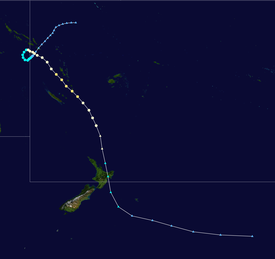Cyclone Fergus
| Category 3 severe tropical cyclone (Aus scale) | |
|---|---|
| Category 2 tropical cyclone (SSHWS) | |
 Severe Tropical Cyclone Fergus | |
| Formed | December 23, 1996 |
| Dissipated | January 1, 1997 |
| (Extratropical after December 29, 1996) | |
| Highest winds | 10-minute sustained: 150 km/h (90 mph) 1-minute sustained: 165 km/h (105 mph) |
| Lowest pressure | 955 hPa (mbar); 28.2 inHg |
| Damage | $2 million (1996 USD) |
| Areas affected | The Solomon Islands, Vanuatu, New Caledonia and New Zealand |
| Part of the 1996–97 South Pacific and Australian region cyclone seasons | |
Severe Tropical Cyclone Fergus was a tropical cyclone, later becoming an extratropical cyclone, that affected islands in the south-west Pacific Ocean. It lasted from December 23, 1996, to January 1, 1997, and reached speeds of up to 165 kilometers per hour, or 90 miles per hour. In addition to its winds, the storm caused heavy rains and severe flooding, causing significant damage to property in some areas.
Meteorological history

Tropical storm (39–73 mph, 63–118 km/h)
Category 1 (74–95 mph, 119–153 km/h)
Category 2 (96–110 mph, 154–177 km/h)
Category 3 (111–129 mph, 178–208 km/h)
Category 4 (130–156 mph, 209–251 km/h)
Category 5 (≥157 mph, ≥252 km/h)
Unknown
The precursor tropical disturbance to Severe Tropical Cyclone Fergus was first noted by the United States
After being named, Fergus performed a cyclonic loop in an area of weak steering flow, before it started to move south-eastwards, under the influence of an approaching upper level trough of low pressure.
Preparations, impact and aftermath
Fergus and its precursor tropical disturbance brought strong winds and heavy rain to the Solomon Islands, which caused serious flooding on the islands of
After impacting the Solomon Islands, Fergus moved south-eastwards where it moved in between and parallel to Vanuatu and New Caledonia's Loyalty Islands.
Ahead of the system impacting New Zealand, MetService issued warnings for gale-force winds and heavy rain in various districts of the North Island.[17] They also warned that Fergus would bring with it around about thirty hours of rain and six to eight hours of damaging winds.[18] As a result, all campers and hikers who were holidaying on the North Island's East Coast were told to pack up and leave the area.[18] Ahead of Fergus impacting New Zealand, the ground was becoming saturated as a shallow trough of low pressure and moist northeast flow, had caused rain to set in from Northland to the Bay of Plenty.[17] Fergus caused extensive damage in New Zealand after making landfall.[19]
Play in the qualifying and first rounds of the 1997 ASB Classic tennis tournament to be significantly disrupted, due to torrential rain, poor light and strong wind caused by Fergus.
References
- ^ a b c d "JTWC best track analysis: Tropical Cyclone 16P (Fergus)". United States Joint Typhoon Warning Center. Archived from the original on May 25, 2015.
- ^ "Tropical Cyclone Formation Alert December 20, 1996 13z". United States Joint Typhoon Warning Center. December 20, 1996. Archived from the original on January 5, 2018. Retrieved January 8, 2017.
- ^ "Tropical Cyclone Formation Alert Cancellation December 21, 1996 14z". United States Joint Typhoon Warning Center. December 20, 1996. Archived from the original on January 5, 2018. Retrieved January 8, 2017.
- ^ a b "Tropical Cyclone Formation Alert December 23, 1996 15z". United States Joint Typhoon Warning Center. December 23, 1996. Archived from the original on January 5, 2018. Retrieved January 8, 2017.
- ^ a b c Hanstrum, B N; Bate P W. "The South Pacific and Southeast Indian Ocean Tropical Cyclone Season 1996–97" (PDF). Australian Meteorological Magazine. 48. Australian Bureau of Meteorology: 121–138. Archived from the original (PDF) on March 21, 2012. Retrieved May 29, 2011.
- ^ "JTWC Tropical Cyclone Warning 1 December 24, 1996 03z". United States Joint Typhoon Warning Center. December 24, 1996. Archived from the original on January 5, 2018. Retrieved January 8, 2017.
- ^ "JTWC Tropical Cyclone Warning 3 December 25, 1996 03z". United States Joint Typhoon Warning Center. December 25, 1996. Archived from the original on January 5, 2018. Retrieved January 8, 2017.
- ^ a b "1996 Tropical Cyclone Fergus (1996354S05170)". International Best Track Archive for Climate Stewardship. Retrieved January 26, 2020.
- ISSN 1321-4233. Archived (PDF) from the original on March 4, 2016. Retrieved January 8, 2017.)
{{cite report}}: Unknown parameter|agency=ignored (help - ^ a b c d "YACHTING Dreaded Drena". Pacific Islands Monthly. Vol. 67. 1 March 1997. p. 54-55. Retrieved 24 October 2021 – via National Library of Australia.
- ^ a b "BBC Summary of World Broadcasts: Taiwan donates seeds to victims of Cyclone Fergus". BBC. January 20, 1997. – via Lexis Nexis (subscription required)
- ^ a b c "BBC Summary of World Broadcasts: Taiwan donates disaster relief". BBC. January 9, 1997. – via Lexis Nexis (subscription required)
- ^ "Solomon Islanders ordered to higher ground in face of cyclone". Agence France Presse. January 5, 1997. – via Lexis Nexis (subscription required)
- ^ "New Caledonia islands on cyclone alert". Agence France Presse. December 28, 1996. – via Lexis Nexis (subscription required)
- ^ Daniels, Chris (January 10, 1997). "Cyclone sends campers packing". The Dominion. – via Lexis Nexis (subscription required)
- ISBN 978-0-387-71542-1. Retrieved August 3, 2014.
- ^ a b "Cyclone Fergus". MetService. Archived from the original on November 11, 2004. Retrieved January 8, 2016.
- ^ a b "North Island prepares for cyclone". The Associated Press. December 29, 1996. – via Lexis Nexis (subscription required)
- )


